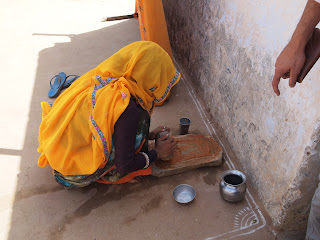Today we visited a school supported by the Grand Circle
Foundation, which was set up by Oversaes Adventure Travel, our tour company. Part of their profits go to the Foundation and individuals may also contribute.
The day opened with prayer (which started with "Ommmmm"). We were instant celebrities. The kids wanted us to take pictures so they could see them. On specifically requested, "Selfie". Selfies. The one said, "Autograph?" Suddenly I couldn't write my name on strips of paper fast enough. Mary Beth B gave the teachers a laminated world map-
she observed that the classroom was practically empty except for a blackboard and
chalk.
Our guide told us that a large percentage of the older girls were already "married"- typically this meant a promise was made between the two families and the marriage would be consummated when they were older. Still, our guide noted that this could become awkward, is in the case of one young girl he knew whose betrothed, died before the marriage was consummated. leaving her widowed at a very young age.
Our guide told us that a large percentage of the older girls were already "married"- typically this meant a promise was made between the two families and the marriage would be consummated when they were older. Still, our guide noted that this could become awkward, is in the case of one young girl he knew whose betrothed, died before the marriage was consummated. leaving her widowed at a very young age.
 |
| The only way to get water. |
From there we went to the village of Village Kushal Pura. We got there by a vehicle called “jugaad”
which is Hindi for “workaround” or “improvised”.
Our first assignment was to stop at the local
stands and buy 100 rupees worth of food – our group got salad vegetables,
another got vegetables to cook and another got fruit. We also had to learn the Indian names! We watched a group grinding alfalfa for the
livestock. Another group was harvesting
wheat.
Interestingly, when Mary Beth and
I wanted to buy cauliflower and cabbage for the salad, the vendor said, “no
salad”- apparently they don’t consider cauliflower and cabbage as foods to be
eaten raw. We toured the village while
the local people made our meal.
Part of the tour included a conversation with a couple of
local leaders; our guide interpreted.
One older woman seated on the ground, was surprised to hear that in the
US we had no caste system. How did we
know whom to marry? (We explained that
frequently it was a function of similar economic and educational
backgrounds.) She herself had been
married since age 9. (Typically this is
only a type of formal commitment but the actual marriage and consummation occur
after puberty.) In addition to wrist
bangles, which I learned were a sign that the woman was married, she wore heavy
silver bands around her ankles, which would be removed only at her death.
Lunch was delicious- it was served in plates and bowls made
from dried pressed leaves. In addition
to cooking with what we’d supplied, they added a chutney ground by a woman
while we watched, and a confection made from cane syrup.
Mary Beth was one of the women getting henna designs on her hands after lunch.
It was an odd contrast going back to our hotel. Dinner that night was on a restaurant rooftop
with dancers and musicians entertaining us.










No comments:
Post a Comment